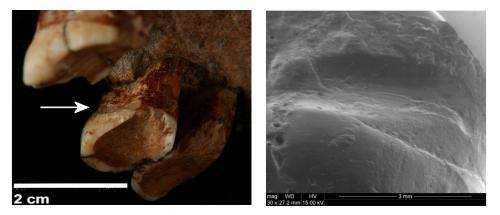Neanderthals used toothpicks to alleviate the pain of diseases such as inflammation of the gums

Removing food scraps trapped between the teeth one of the most common functions of using toothpicks, thus contributing to our oral hygiene. This habit is documented in the genus Homo, as early as Homo habilis, a species that lived between 1.9 and 1.6 million years ago. A new research based on the Cova Foradà Neanderthal fossil shows that this hominid also used toothpicks to mitigate pain caused by oral diseases such as inflammation of the gums (periodontal disease). It is the oldest documented case of palliative treatment of dental disease done with this tool.
It is stated in the article "Toothpicking and periodontal disease in a Neanderthal specimen from site Cova Foradà (Valencia, Spain)", published by PLOS ONE, in its issue of October 16. It has been written by Marina Lozano, Carlos Lorenzo and Gala Gomez of the IPHES (Institut Català de Paleoecologia Humana I Evolució Social), in collaboration with Maria Eulalia Subirà, Biological Anthropology professor and researcher at the Universitat Autònoma de Barcelona (UAB), and José Aparicio of the Diputació Provincial de València. This research is based on toothpicking marks on the Neanderthal teeth related to periodontal disease.
The chronology of the fossil is not clear, but the fossil remains were associated with a Neanderthal Mousterian lithic industry (about 150,000 to 50,000 years).
The research showed that the remains had maxillary porosity, characteristic of periodontal disease and alveolar bone loss (where the teeth are inserted), with a bone mass reduction of four to eight millimeters exposing the roots of the teeth, usually inside the alveoli. Marina Lozano said: "This individual attempted to alleviate the discomfort caused by periodontal disease. This disease usually causes bloody and inflamed gums, so the systematic use of toothpicks could mitigate sore gums".
The examples of grooves caused by toothpicking are numerous between Neanderthals and usually are not associated with any dental disease. "However, in the case of Cova Foradà the toothpick was not only used as a primitive method of dental hygiene, but it is associated with a dental disease and with the clear intention to alleviate the pain, and that makes it unique", said Marina Lozano.
This means that we have one of the first examples of palliative treatment with toothpicks, the oldest documented. Therefore, "this study is a step to characterize the Neanderthals as a species with a wide range of adaptations to their environment and wide resources even in the field of palliative medicine" says the same researcher.
Journal information: PLoS ONE
Provided by Universitat Autonoma de Barcelona

















